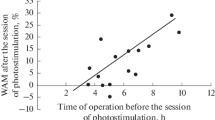abstract
We studied the effect of electrical stimulation of the visual analyzer (evoking a phosphen phenomenon, the phosphen-electrostimulation, PES) on the visual functions, hemodynamics in the eye and brain, and general immune reactivity; the examined group Included patients afflicted with myopia. It was shown that the main visual functions, like visual keenness under normal and mesopial illumination conditions, accommodation reserves, and light sensitivity, improved under the influence of PES. Circulation in the eye and brain was intensified, as was shown by improvement of the brain blood supply via the main arterial pools and blood supply of the eye via the uveal tract, with a simultaneous decrease In the vascular tone. In addition, PES caused evident total optimization of the immuno-regulatory Processes in an organism.
Similar content being viewed by others
References
Author’s Certificate No. 1531267 (SSSR),A Method for the Treatment of a Partial Nerve Atrophy [in Russian], N. B. Kom-paniets, V. V. Petrovskii, and S. I. Dzhinzhligashvili, Published on May 13, 1985.
V. S. Ponomarchuk, S. B. Slobodyanyuk, V. S. Drozhenko, et al., “A comparative analysis of therapeutic effectiveness of phosphen-electrostimulation at different ophthalmopathologies,” in:Current Problems of Ophtalmology [in Russian], Zaporozhye (1997), p. 17–21.
A.N. Shandurina and V.A. Khil’ko, “Indications for the use of the optic nerve direct electrostimulation method for patients with chiasm zone pathology,”Vestn. Oftalmol.,105, No. 2, 33–37 (1989).
V. Drogenko and V. S. Ponomarchuk, “Treatment of patients with partial optic nerve atrophy by electrical stimulation,” In:XI Congress of the European Society of Ophthalmology (Hungary, Budapest, June l-J, 1997), Budapest (1997), p. 228.
S.B. Slobodyanik and V.S. Ponomarchuk, “Electrical stimu-lation of the visual pathway based on phosphen phenomenon in amblyopia therapy,” in:XI Congress of the European Society of Ophthalmology (Hungary, Budapest, Ju.nt 1–5, 1997), Budapest (1997), p. 193.
A.V. Khvatova, A.A. Yakovlev, and T.B. Kruglova, “Trans-cutaneous electrostimulation of the visual system primary ele-ments in children after the extraction of an Innate cataract,”Vestn. Oftalmol.,108, Nos. 4/6, 15–17 (1992).
V.F. Aliferova,Pathology of the Cranial Nerves [in Russian], Zhdorovye, Kiev (1990).
E.V. Rogatina, “Methods of a transcutaneous electrostimulation of the visual pathways at the optic nerve atrophy,”Vestn. Oftalmol., No.I, 25–28 (1997).
V. V. Babaeko and O. N. Kryukovskikh, “To the question about the mechanisms of a visual function activation resulting from electrical stimulation of the eyeball,” in:Proceedings of Con-ference ‘Comparative Physiology of the Higher Nervous Activity’ [in Russian], part I, Moscow (1998), p. 15.
E.B. Lyskov and A.N. Shandurina, “Neurophysiological mechanisms of the visual disturbance compensation following electrostimulation of human damaged optic nerves,”Fiziol. Cheloveka,13, No. 6, 1029–1031 (1987).
G. I. Nemtseyev, V. B. Polyansldi, and G. L. Ruderman, “Functional results of the treatment of patients suffering from a partial optic nerve atrophy using transcutaneous stimulation of the visual pathway,” in:Problems of Neurocybernetics [in Russian], lzdatel’stvo RGU, Rostov-on-Don, (1989), p. 311–312.
V.B. Polyanskii, G.L. Ruderman, and E.B. Kompaneyets, “The change of the visual analyzer psychophysiological charac-teristics in week-vision patients with different forms of retinal and optic nerve pathology following a transcutaneous electrostimula-tion of the visual pathway periphery,”Sensornye Sistemy,6, No. 2, 66–77 (1992).
A.N. Shandurina, E.B. Lyskov, and I.M. Nikolskaya, ”Therapeutic electrostimulations as a method to restore visual and mental functions,”Fiziol. Cheloveka,15, No. 3, 69–77 (1989).
A.N. Shandurina, “A recovery of visual and auditory functions with the aid of electrostimulation,”Fiziol. Cheloveka,21, No. 1, 25–29 (1995).
Author information
Authors and Affiliations
Rights and permissions
About this article
Cite this article
Ponomarchuk, V.S., Degtyarenko, T.V., Chaura, A.G. et al. Mechanisms responsible for the curative effect of phosphen-electrostimulation. Neurophysiology 30, 431–434 (1998). https://doi.org/10.1007/BF03027698
Issue Date:
DOI: https://doi.org/10.1007/BF03027698




